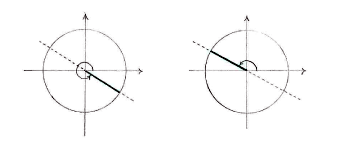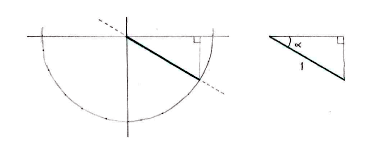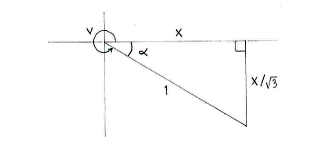Lösung 4.4:1g
Aus Online Mathematik Brückenkurs 1
K (hat „Solution 4.4:1g“ nach „Lösung 4.4:1g“ verschoben: Robot: moved page) |
|||
| Zeile 1: | Zeile 1: | ||
| - | + | Zeichnen wir den Einheitskreis mit der Geraden <math>y=(-1/\!\sqrt{3})x</math>, was also den Winkel mit den Tangens <math>-1/\!\sqrt{3}</math> entspricht, sehen wir dass es zwei Winkeln gibt die die Gleichung <math>\tan v = -1/\!\sqrt{3}</math> erfüllen. Diese liegen gegenüber von einander im zweiten und im vierten Quadrant. | |
[[Image:4_4_1_g1.gif|center]] | [[Image:4_4_1_g1.gif|center]] | ||
| - | + | Wir betrachten nur den vierten Quadrant, und führen ein neues Dreieck ein, siehe Bild. | |
[[Image:4_4_1_g2.gif|center]] | [[Image:4_4_1_g2.gif|center]] | ||
| - | + | Wir benennen die Ankathete <math>x</math> und nachdem <math>\tan v=-1/\!\sqrt{3}</math> ist die Länge der Gegenkathete <math>x/\!\sqrt{3}</math>. | |
[[Image:4_4_1_g3.gif|center]] | [[Image:4_4_1_g3.gif|center]] | ||
| - | + | Durch das Gesetz des Pythagoras erhalten wir | |
{{Abgesetzte Formel||<math>x^2 + \Bigl(\frac{x}{\sqrt{3}}\Bigr)^2 = 1^2</math>}} | {{Abgesetzte Formel||<math>x^2 + \Bigl(\frac{x}{\sqrt{3}}\Bigr)^2 = 1^2</math>}} | ||
| - | + | Diese Gleichung hat die positive Lösung <math>x = \sqrt{3}/2</math>, und also haben wir | |
{{Abgesetzte Formel||<math>\cos\alpha = \frac{\sqrt{3}/2}{1} = \frac{\sqrt{3}}{2}\,,</math>}} | {{Abgesetzte Formel||<math>\cos\alpha = \frac{\sqrt{3}/2}{1} = \frac{\sqrt{3}}{2}\,,</math>}} | ||
| - | + | also ist <math>\alpha = \pi/6</math>. Nachdem der Winkel <math>v</math> das Komplement des Winkels <math>\alpha</math> ist, ist <math>v</math> | |
{{Abgesetzte Formel||<math>v = 2\pi - \alpha = 2\pi - \frac{\pi}{6} = \frac{11\pi }{6}\,\textrm{.}</math>}} | {{Abgesetzte Formel||<math>v = 2\pi - \alpha = 2\pi - \frac{\pi}{6} = \frac{11\pi }{6}\,\textrm{.}</math>}} | ||
| - | + | Subtrahieren wir <math>\pi</math> von <math>v</math> erhalten wir den anderen Winkel in zweiten Quadrant, | |
{{Abgesetzte Formel||<math>v = \frac{11\pi}{6} - \pi = \frac{5\pi}{6}\,\textrm{.}</math>}} | {{Abgesetzte Formel||<math>v = \frac{11\pi}{6} - \pi = \frac{5\pi}{6}\,\textrm{.}</math>}} | ||
Version vom 20:47, 5. Apr. 2009
Zeichnen wir den Einheitskreis mit der Geraden \displaystyle y=(-1/\!\sqrt{3})x, was also den Winkel mit den Tangens \displaystyle -1/\!\sqrt{3} entspricht, sehen wir dass es zwei Winkeln gibt die die Gleichung \displaystyle \tan v = -1/\!\sqrt{3} erfüllen. Diese liegen gegenüber von einander im zweiten und im vierten Quadrant.
Wir betrachten nur den vierten Quadrant, und führen ein neues Dreieck ein, siehe Bild.
Wir benennen die Ankathete \displaystyle x und nachdem \displaystyle \tan v=-1/\!\sqrt{3} ist die Länge der Gegenkathete \displaystyle x/\!\sqrt{3}.
Durch das Gesetz des Pythagoras erhalten wir
| \displaystyle x^2 + \Bigl(\frac{x}{\sqrt{3}}\Bigr)^2 = 1^2 |
Diese Gleichung hat die positive Lösung \displaystyle x = \sqrt{3}/2, und also haben wir
| \displaystyle \cos\alpha = \frac{\sqrt{3}/2}{1} = \frac{\sqrt{3}}{2}\,, |
also ist \displaystyle \alpha = \pi/6. Nachdem der Winkel \displaystyle v das Komplement des Winkels \displaystyle \alpha ist, ist \displaystyle v
| \displaystyle v = 2\pi - \alpha = 2\pi - \frac{\pi}{6} = \frac{11\pi }{6}\,\textrm{.} |
Subtrahieren wir \displaystyle \pi von \displaystyle v erhalten wir den anderen Winkel in zweiten Quadrant,
| \displaystyle v = \frac{11\pi}{6} - \pi = \frac{5\pi}{6}\,\textrm{.} |



